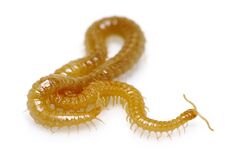Biology:Haplophilus subterraneus
| Haplophilus subterraneus | |
|---|---|

| |
| Scientific classification | |
| Domain: | Eukaryota |
| Kingdom: | Animalia |
| Phylum: | Arthropoda |
| Subphylum: | Myriapoda |
| Class: | Chilopoda |
| Order: | Geophilomorpha |
| Family: | Himantariidae |
| Genus: | Haplophilus |
| Species: | H. subterraneus
|
| Binomial name | |
| Haplophilus subterraneus (Shaw, 1794)
| |
| Synonyms[1] | |
| |
Haplophilus subterraneus, commonly known as the western yellow centipede is a species of centipede in the family Himantariidae that can be found in Central Europe, Ireland, Newfoundland, Scandinavia and the United Kingdom.[1] It was recorded from a compost heap of the Botanical Garden at the University of Oslo at Teryen, Oslo in 1992 and 1995.[2]
It was for some time known as Stigmatogaster subterranea, but the name was reverted back to Haplophilus subterraneus in 2014.[3][4]
Description
It is fairly large, measuring up to, and sometimes exceeding, 70 mm in length. It has 77 to 83 leg pairs.[4]
Distribution
Haplophilus subterraneus is widespread in central and eastern Europe, along with the British isles, and has also been introduced to Newfoundland and New York.[5][6] It is common in woods and grassland habitats, and is also commonly found in gardens and other syanthropic habitats.[7][8]
Morphological anomalies
Several papers have reported high levels of morphological anomalies in H. subterraneus. One study found that on average, 30% of individuals may have some kind of anatomical deformity.[8]
References
- ↑ 1.0 1.1 A. D. Barber (2013). "Stigmatogaster subterranea". World database of littoral Myriapoda. World Register of Marine Species. http://www.marinespecies.org/aphia.php?p=taxdetails&id=394620.
- ↑ Kjell Magne Olsen (2000). "Haplophilus subterraneus (Shaw, 1789), a centipede (Chilopoda, Geophilomorpha) new to Norway". Norwegian Journal of Entomology 47: 63–64.
- ↑ Barber, A.D. (2014). "GEOPHILOMORPHA OF EUROPE: SOME SYNONYMIES AND NAME CHANGES". Bulletin of the British Myriapod & Isopod Group 27: 62. https://www.bmig.org.uk/sites/www.bmig.org.uk/files/bulletin/BullBMIG27-2014.pdf#page=64.
- ↑ 4.0 4.1 "Haplophilus subterraneus (Shaw, 1794) | British Myriapod and Isopod Group". https://www.bmig.org.uk/species/Haplophilus-subterraneus#tabs-0-tabs-1.
- ↑ Tuf, Ivan Hadrián; Tajovsky, Karel (12 April 2016). "An annotated checklist of the centipedes (Chilopoda) recorded in the Czech Republic". Acta Soc. Zool. Bohem 80: 45–50. ISSN 1211-376X. http://myriapoda.upol.cz/assets/aszb/Tuf+Tajovsky2016.pdf.
- ↑ Andersonian Naturalists of Glasgow.; Glasgow, Andersonian Naturalists of; Society, Glasgow and Andersonian Natural History and Microscopical; Society, Glasgow Natural History; Glasgow, Natural History Society of (2002). The Glasgow naturalist. 24. Glasgow: Glasgow Natural History Society. https://www.biodiversitylibrary.org/item/225813.
- ↑ London Natural History Society.; Society, London Natural History (2001). London Naturalist. London: London Natural History Society. https://www.biodiversitylibrary.org/item/268653.
- ↑ 8.0 8.1 "MORPHOLOGICAL ANOMALIES IN HAPLOPHILUS SUBTERRANEUS (SHAW, 1794) (CHILOPODA: GEOPHILOMORPHA).". Bulletin of the British Myriapod & Isopod Group 26: 54–55. 2012. https://www.bmig.org.uk/sites/www.bmig.org.uk/files/bulletin/BullBMIG26-2012.pdf#page=56.
External links
- Haplophilus subterraneus on iNaturalist
- Haplophilus subterraneus at the Biodiversity Heritage Library
External links
Wikidata ☰ Q4351357 entry
 |


